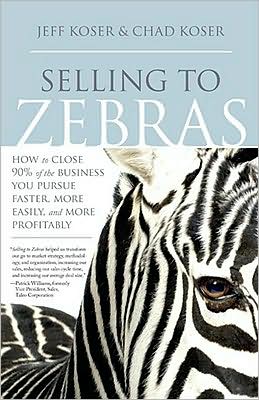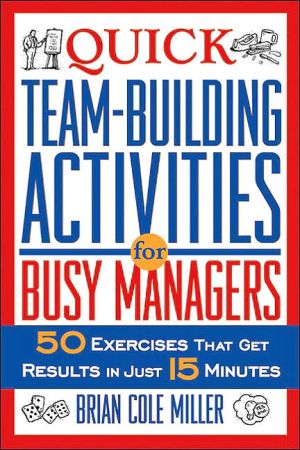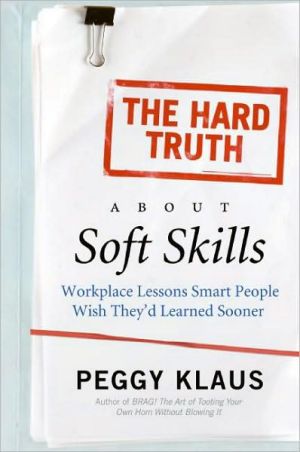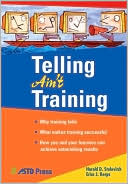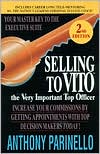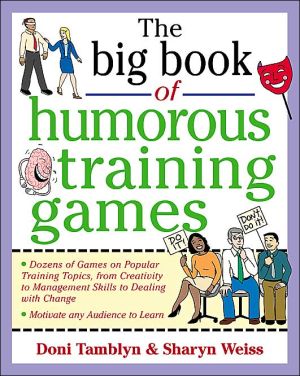Selling to Zebras: How to Close 90% of the Business You Pursue Faster, More Easily, and More Profitably
Even the most competitive companies only close about 15 percent of the deals in their sales pipelines. That means that salespeople spend time with prospects who, 85 percent of the time, aren't going to buy. Wouldn't those salespeople rather spend more time pursuing prospects they knew they could close? Or spend time with their prospects where it matters most at an executive level? Readers who are ready for exceptional results for themselves and their companies need Selling to Zebras.\ \ The...
Search in google:
Even the most competitive companies only close about 15 percent of the deals in their sales pipelines. That means that salespeople spend time with prospects who, 85 percent of the time, aren't going to buy. Wouldn't those salespeople rather spend more time pursuing prospects they knew they could close? Or spend time with their prospects where it matters most at an executive level? Readers who are ready for exceptional results for themselves and their companies need Selling to Zebras.The Zebra way can help salespeople identify the perfect prospects for their companies--their Zebras--and develop a sales process that will help them close deals 90 percent of the time.The Zebra method of selling will: * Increase close rates * Shorten sales cycles * Increase average deal size * Reduce discounting and increase margins * Make better use of scarce resources * Make customers happy, creating a stable of great referencesJeff and Chad Koser don't just offer theories and concepts. They give readers specific tools, models, and spreadsheets they can customize to make the Zebra way the best way for their companies to do business.
SELLING TO ZEBRAS HOW to CLOSE 90% of the BUSINESS YOU PURSUE FASTER, MORE EASILY, and MORE PROFITABLY \ \ By JEFF KOSER CHAD KOSER Greenleaf Book Group Press \ Copyright © 2009 Jeff Koser and Chad Koser\ All right reserved.\ ISBN: 978-1-929774-57-9 \ \ \ Chapter One HUNTING ZEBRAS \ EVER HAD A NICE FAT BONUS-THE KIND that makes your year? Want more just like it? If you haven't had one, don't you want one? Well, we can tell you how to make it happen. It's as simple as changing how and where you spend your time and resources.\ First, ask yourself, "How often do I spend time on prospects that are long shots?" If you're like most salespeople, your answer is probably "pretty often." The simple truth is that salespeople work hard to get the business they score, but many of the hardest-working people in sales are the least successful. This reality exists because most salespeople believe that the only way to close more sales is to pursue every opportunity for every possible prospect. That approach isn't effective in the current business environment. Here's a wake-up call.\ WAKE-UP CALL\ The most competitive company in an industry closes about 15 percent of its forecasted sales, and its competitors close another 15 percent.\ 70 percent of the prospects in an industry-the sales everybody is fighting for-will never buy from anyone.\ Sales, marketing, sales engineers, customer service, sales management,and lots of other employees waste 85 percent of their time on activities that will never result in a sale.\ Calls from salespeople waste a prospect's energy 85 percent of the time, too.\ So why are sales teams spending time developing and executing activity-intensive sales techniques to reach prospects who, 85 percent of the time, will not buy? Why do so many salespeople waste time and energy on something that will never produce the desired result? Because the traditional model of sales management is driven by the philosophy that all sales activity is good activity. Do your sales goals look like this?\ Talk with 100 prospects in order to\ Get 25 appointments, so you can ...\ Do 12.5 prospect surveys, which will lead to ...\ About 6.25 proposals, and ultimately to ...\ One sale\ If so, you're operating with an activity-driven sales philosophy. Don't fret, you are not alone! The majority of the sales world is still preaching and practicing the activity-driven approach. The end result of building your sales strategies around this worn-out philosophy is that valuable sales time and resources are wasted 85 percent of the time. You need to consider a new approach.\ In many ways, salespeople are like lions. Lions need sharp focus to catch enough food to survive, but not all lions hunt the same way. Unlike experienced, disciplined lions, young lions often fail to focus on prey that they can catch and that will effectively feed the pride. They'll take a swipe at any food source within sight, often to no avail, and then pursue another and another until all their energy is spent and they have to abandon the hunt. Like a good salesperson, however, the experienced lion knows that the better strategy is to focus on prey that is worth the energy to pursue, like a zebra.\ In a typical year, most salespeople in our complex business environment work a limited number of opportunities. So, spending time and money on an unqualified prospect can be a tremendous drain on a company. When salespeople pursue every opportunity that catches their attention, they exhaust their limited resources until they have nothing left to continue the hunt. Ultimately, even the business that could have been won is often lost, making survival in the wild world of sales increasingly difficult.\ There was a time when more activity produced greater results, but too much has changed to make that approach workable. There are more competitors in every industry, and they have better access to information. They figure out your strengths and work hard and fast to emulate them. Prospects are now saying that it's hard to distinguish between different options. To most prospects, everyone in the market looks the same, and many of the competitive differences that companies can claim don't seem to matter. As products begin to appear equal, price becomes more important to customers. Margins have been bled from many industries because India, China, and other developing countries are creating downward price pressure. Their low-cost development and manufacturing resources contribute to the lowest-cost game. Sales are lower, margins are lower, and there is more competition than the market can support.\ It doesn't matter if you sell tangible or intangible products and services, large- or small-ticket items: the activity-based sales approach no longer works! Sales can no longer be a numbers game. Old-school methods targeting sheer volume of leads and knocking on every door with equal vigor have been proven vastly ineffective, not to mention expensive. Effort alone is no longer enough to be competitive. If effort is the key to your strategy, you will go hungry. Instead of chasing anything that moves, why not hunt zebras? It's time to heed the old cliché about working smarter, not harder.\ The Zebra\ How would it feel if you could spend more time pursuing prospects that you knew you could win? How would it feel to spend time with those prospects where it matters most-at an executive level? How would it feel if you could get home on time at night and be more involved with family and friends? If you are like most salespeople and you waste 85 percent of your energy on prospects that are poor fits for your product or service, company, or sales strategy, your best chance to improve your sales, build a stable of happy customers, and have a life outside of work is to find your Zebra and develop a method for selling to it.\ Your Zebra is the prospect that is a perfect fit for your company-and not just from a product or solution perspective. It is a prospect that you know you can win based on identifiable, objective characteristics-and Zebras are the only prospects a salesperson should pursue. We call this perfect prospect a Zebra because once you've identified the characteristics of your Zebra, you can quickly and easily spot it amid all the other prospects. A Zebra's stripes tell you exactly what kind of animal you're looking at-you can't mistake a Zebra for any other animal, so you know for sure when you have one.\ Most good salespeople have an instinct for Zebras. You know in your gut when you've found a prospect that offers you a good chance. It's the perfect prey, and the time and money you spend pursuing this prospect are going to pay off. But you still pursue lots of prospects that aren't Zebras because you believe that if you work hard enough, you can close those deals, too. This is a fallacy that most salespeople believe.\ Here's the problem. These companies or individuals may or may not buy from someone, but they aren't going to or shouldn't buy from you. The reason? Their needs don't line up with what your company delivers. You can chase them all you want, but you'll never be able to deliver the solution that meets their needs. If you're focused on pursuing anything other than Zebras, you're just chasing whatever happens to step into view. And putting your energy toward the wrong focus is just as detrimental to sales success as being unfocused.\ WAKE-UP CALL\ Many great sales authors have devoted text to the importance of profiling your market niche and have helped establish why every company needs a Zebra. Yet most companies agree that although this strategy is generally best, they fail to live by it.\ Part of the reason you pursue less-than-ideal prospects is because you can't articulate what makes a Zebra a Zebra. You may instinctually recognize it, but you can't develop a sales strategy based on your Zebra because you don't really understand what it looks like. You haven't identified your Zebra's unique stripes.\ If we know that we want to pursue Zebras, why not take the sales process out of the realm of instinct and chance and approach it with direction and discipline? The purpose of this book is to help you do exactly that by showing you how to find your Zebra and how to develop a sales methodology specifically suited to catching the Zebra. We will teach you how to identify Zebras and earn the right to spend time with them at the executive level so that your time is spent where you have the best possible chance of closing the sale-with the decision maker. And we'll show you how the results of using the Zebra methodology go far beyond improved sales.\ By focusing only on Zebras it is possible to close as much as 90 percent of the business in your sales pipeline. As a result, you will have greater sales success than you imagined possible, and your life will be richer, more exciting, and more personally rewarding. Want to earn that big bonus again? Learn to identify conventional "sales wisdom" that has sent you chasing after other animals in the past and you can eliminate those fruitless pursuits, freeing up the bulk of your time to spend on Zebras.\ WAKE-UP CALL\ You may think that if you pursue only Zebras, you'll risk selling less than you are now. It's true that when you first start focusing on Zebras, your potential sales pipeline will decrease in overall value. But if you're closing 90 percent instead of 15 percent, this short-term discomfort will be worth it. And because you won't be wasting time on prospects that will never buy from you, you'll have more time to pursue quality accounts where you add unique value. You'll have time to strategize the accounts that are worth your valuable time and sales resources. You'll be able to review your Zebras, determine and leverage your strengths, and identify and devise strategies to address your weaknesses. This is the real strength of the Zebra way. The more you identify and chase Zebras, the faster the deals in your pipeline will turn into revenue, the less discounting will be required to close business, and the faster your business will grow.\ WHY YOU NEED THE ZEBRA\ Making the changes necessary to follow the Zebra way may require a major catalyst for some of you-but if you wait that long, it may be too late. We'll share a true story to help you see how a real person (names have been changed) developed the will and the method to change and overcome a catastrophe. We'll return to our story frequently throughout the book to help you understand how the concepts and tools presented have been used in the real world.\ Can you feel Kurt's stomach churn? Will it take a catastrophic event like Kurt's before you consider a change? Obviously, his boss, Scotty, is devoted to the activity-based sales approach, and Kurt is right to question the drive for activity as a solution to their problems. Kurt's situation may be familiar to some of you. And if it isn't, it might be in the near future if you aren't considering new ways of doing business-new ways of addressing your critical sales issues.\ The most successful salespeople in the world have something in common: they know how to identify and address their critical sales issues. Do you know what your critical sales issues are? Could you make a list right now, without too much thought or analysis? If you're like most salespeople, your list will probably look like this:\ WAKE-UP CALL\ Sales cycles are getting longer and often end with no decision-they just linger in limbo.\ Qualified prospects are difficult to find and identify-your pipeline is clogged.\ Sales opportunities are aging and staying on the forecast longer-and time kills all deals.\ Products and services are becoming increasingly commoditized-prospects are saying, "All products and solutions look alike."\ Deals are getting smaller and margins are diminishing-heavy discounting is the norm.\ Access to high-level decision makers is harder to get-the number of competitors in every market is on the rise.\ If you are facing these hurdles, you're not alone. Every client we've worked with has been affected by at least one of these issues. And increasing sales activity doesn't help a company address them. By focusing on activity rather than productivity and overcoming critical sales issues, sales teams are burning through dwindling resources and having a tougher time making their numbers.\ Some of the wasted effort in sales is a consequence of the fact that most sales are initiated by a prospect, often with a request for proposal (RFP) or a request for information (RFI). As salespeople we expend much of our energy keeping ourselves involved in the competition of customer-initiated and customer-driven sales cycles where we never had a chance to win in the first place. We feel we must respond, and we do so without fully qualifying the opportunity, considering the resources we're expending to pursue it, or evaluating how likely it is that we'll win the business.\ Additionally, large, hot prospects are often allowed to change R&D priorities. As a result, R&D teams can never finish new product releases on time because the sales staff is always bringing in the next big opportunity, changing their priorities. R&D is whipsawed around, missing deadlines, and credibility suffers. Sales fall behind the competition, and a chain of events has begun that will result in closing even less business in the future.\ Another element that has pulled our attention toward activity levels and away from results is the advent of customer relationship management (CRM) systems. The proliferation of CRM systems has automated the collection and analysis of data, which makes it easy to generate reports on sales activity. The activity that we enter into CRM systems falsely encourages us, implying that we're productive simply because our activity levels are high. Problematically, companies and individuals end up using CRM systems to measure the quantity of sales activity rather than the quality, requiring salespeople to spend countless hours logging the quantitative data. But CRM systems also offer the benefit of collaboration and the ability to measure actual progress and productivity; unfortunately, most companies do not take advantage of this asset. Using the Zebra model in conjunction with a solid CRM can actually help you identify and overcome your sales hurdles.\ Putting sales activity quantity ahead of quality generally yields a very poor return on investment (ROI) within both sales and business-development departments. Available people resources are torn in many directions by the sales department. There's such a push to attain the required activity levels that salespeople fail to focus that activity where it truly matters. As a result, there is little time left to actually work the deals that should be won; resources are scattered in many directions rather than concentrated on only the most viable opportunities.\ With the Zebra model, you'll have the information you need to decide to pull out of unfavorable cycles and respond with full energy to those opportunities that fit your Zebra profile. Wouldn't that be a great way to do business?\ All of this pointless activity not only prevents focus on the most important sales issues but also leads to further problems down the line. When we pursue opportunities that aren't a good fit for us and somehow actually win the business, we often end up sacrificing quality and margins and adding to the list of unhappy customers.\ WAKE-UP CALL\ When you sell to customers who shouldn't be buying your solution or product, you end up with\ High discounting that results in low margins\ Lack of knowledge of the customer's business and industry\ An ineffective plan for implementation\ Post-implementation customer problems that drain company resources\ Poor reputation in the market\ And how does this intense focus on activity over productivity affect the inner workings of a company? Usually it results in poor-quality sales proposals, unrealistic timelines for everybody involved in the sale, low morale as more employees are forced to deal with the issues of unhappy customers, and less time to think and act strategically because everybody's focus is on managing crises.\ (Continues...)\ \ \ \ \ Excerpted from SELLING TO ZEBRAS by JEFF KOSER CHAD KOSER\ Copyright © 2009 by Jeff Koser and Chad Koser. Excerpted by permission.\ All rights reserved. No part of this excerpt may be reproduced or reprinted without permission in writing from the publisher.\ Excerpts are provided by Dial-A-Book Inc. solely for the personal use of visitors to this web site. \ \ \ Contents THE ZEBRA WAY 1 Hunting Zebras....................3\ 2 Develop Your Zebra Profile....................25\ ZERO IN ON YOUR ZEBRA 3 Spot Your Zebra....................61\ 4 Define Power's Pain Points....................87\ 5 Predict the Value of Your Solution....................109\ PARTNER WITH YOUR ZEBRA 6 Meet with Power....................141\ 7 Partner to Verify Your Value....................175\ CATCH YOUR ZEBRA 8 Contract and Force Success....................201\ 9 Operations for the Zebra Way....................215
